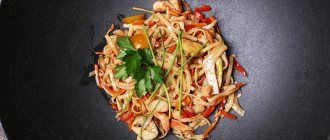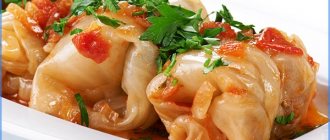Stuffed cabbage rolls have become so firmly established in Russian cuisine that they can be called a homemade dish. In Europe and America, they are more of a rarity, so they belong to the category of festive dishes that coincide with some event.
A large number of information from various sources, from archives to literary works, cannot give a definite answer about the origin of cabbage rolls. There is evidence that the impetus for the spread of the dish around the globe was given by the emigration of people from Eastern European and Scandinavian countries. However, this can be attributed to the second birth of the dish, but how and where it came from in those places remains unknown. Culinary historians almost unanimously recognize the eastern origin of cabbage rolls, and in the United States they are classified as Jewish cuisine.
Eastern Europe
The traditional filling for cabbage rolls is meat and rice.
Eastern Europeans treat cabbage rolls very warmly and reverently. Each nation has its own name for the dish, and the cooking technology is distinguished by subtle nuances and national flavor. There is often some legend or story associated with stuffed cabbage leaves.
The oldest recipe for cabbage rolls is Jewish holishkes, and there are two options for their preparation. In the first version, minced meat and rice are wrapped in cabbage leaves, and in the other, the filling is mixed rice and raisins with lemon zest. The dish is stewed in tomato sauce.
Bulgarians honestly admit that cabbage rolls (zelevi sarmi in Bulgarian) were borrowed from their closest neighbors, the Greeks and Turks. Traditional minced meat includes a mixture of pork and beef, which always contains a lot of paprika. Stuffed cabbage rolls are eaten with yogurt mixed with mint.
For Romanians, cabbage rolls are sarmale, which are served at celebrations. During the Christmas holidays, their presence on the table means wealth and prosperity in the house. True Romanian gourmets believe that minced meat must be pork and contain dill. Also, in their opinion, the most delicious sarmale should be stewed on sauerkraut, which covers the bottom of the dish. Not only are the cabbage rolls placed on such a pillow, but thinly sliced bacon is placed on top of them. They use an oven to prepare it and serve it exclusively with black bread.
Ukrainian-style cabbage rolls are a substantial dish with a thick sauce that is flavored with garlic. Minced meat is made with the addition of parsley, rice, sweet pepper and sometimes even millet. The Ukrainian version of cabbage rolls is probably the only one where garlic is present in the recipe. The culture of Czechs and Slovaks is close to Ukrainian, so the cooking method remains virtually unchanged. Only the name of the dish is more romantic, doves, since, according to popular belief, they can bewitch a loved one forever.
The proud peoples of Serbia and Croatia do not recognize any influence on the origin of cabbage rolls, which they call sarma. At the same time, their recipe is no different from the cooking method of their neighbors.
The poetic Lithuanian people call cabbage rolls - small pigeons. Their minced meat is enriched, in addition to traditional rice, with eggs, two types of onions - green and onions, as well as bell pepper. Some recipes may contain pearl barley.
Stuffed cabbage rolls in Belarus and Russia are prepared in accordance with the basic recipe, only they have some national flavor, which only enriches the taste.
According to Poles, cabbage rolls are pigeon legs. According to the traditional Polish recipe, the filling is wrapped in cabbage leaves, but fermented. Moreover, minced meat can be of two types. The first filling option consists of potatoes and buckwheat, and the second is the usual filling of minced meat and rice.
Stuffed cabbage rolls in Ukraine[edit | edit code]
In the Carpathians, cabbage rolls are traditionally prepared with corn grits; in the Poltava region it is customary to cook with buckwheat and cracklings. In Ukraine, cabbage rolls are prepared not only from fresh cabbage leaves, but also from pickled ones, and in the spring, young beet leaves are often used. In the west of Ukraine, it is customary to make small cabbage rolls by cutting a cabbage leaf into several parts; in the south and east, cabbage rolls are made from a whole leaf; large cabbage rolls are considered juicier. In Transcarpathia, on Christmas Eve they prepare cabbage rolls from pickled cabbage leaves, wrapping them with rice and mushroom filling. [ source not specified 280 days
]
Scandinavia
Scandinavians usually fry cabbage rolls before stewing.
The customs of Scandinavian countries are somewhat different from other European ones, which is also reflected in the method of preparing cabbage rolls. The name does not change, only it sounds in accordance with the language. Cooking cabbage rolls involves pre-frying before stewing. They are always served with boiled potatoes and lingonberry sauce.
However, all this relates to modern times, and the history of cabbage rolls goes back centuries. Various historical events, myths, legends and folk beliefs are associated with them.
Do you need a side dish?
But there is some debate about the side dish. The book “On Tasty and Healthy Food,” popular in Soviet times, states that cabbage rolls are served with mashed potatoes. Probably, many of us will agree that it is very tasty and goes well together. But for some, cabbage rolls are an independent dish that does not need any addition.
In any case, it is not too important how cabbage rolls appeared, because they contain many qualities: both tasty and healthy, suitable for both the daily diet and the holiday table.
China
The Chinese have many instructive stories that contain deep meaning. There is a Chinese version and more than one origin of cabbage rolls.
The first of them tells about a scientist who, by misfortune, fell into a river and drowned. Devoted disciples began to search for his body. To prevent the fish from gnawing it, they decided to distract them with some other food. Rice and cabbage are available in sufficient quantities in China, so they began to wrap the rice in cabbage leaves and send it to the river to feed the fish. However, people develop curiosity regardless of nationality, so one of this company tried an impromptu dish. Its taste turned out to be worthy for human consumption, which was subsequently appreciated by millions of Chinese.
The second version describes the history of the appearance of the dish in a completely different way. Before the wedding, one Chinese girl gathered her girlfriends to chat and learn the secrets of her upcoming married life at a table with treats. The girls were so carried away by describing some of the details of marriage duties that they used everything that came to hand for clarity. And in this case, rice and cabbage were involved. The girls felt sorry to throw away the improvised visual aids, so they decided to cook and eat the rolled and stuffed leaves. I liked the result, and the recipe was successfully distributed throughout China.
Chinese dishes are not fundamentally different from traditional European ones. The Chinese, in addition to the usual methods of preparing cabbage rolls, use a steam bath and a method of quickly frying in a large volume of hot vegetable oil.
Wind from the East
There is a completely fair assumption that cabbage rolls have Turkish and Armenian roots. The specificity of eastern cabbage rolls is that cabbage leaves are replaced by grape leaves. Such a dish in those parts is called dolma, tudma, tulma. Europe became acquainted with this dish in the 15th century. Cabbage is a more familiar product for European cooks, the same can be said about lamb, which has been replaced by more familiar types of meat.
The Swedish version of the penetration of cabbage rolls from the East is associated with the capture of King Charles XII by the Turks and his release in 1709. Therefore, you can offend the Scandinavians by telling them a different story about the origin of their favorite cabbage rolls.
Russian view
In Rus', finely chopped meat and wheat porridge were wrapped in cabbage leaves.
The dish, which in Rus' was called galusha, is a mixture of finely chopped beef with millet porridge, wrapped in a cabbage leaf. The origin of the word “stuffed cabbage” in Russian and its connection with the famous dish are not directly traceable. Vladimir Dal defines the words galusha and cabbage roll as synonyms.
However, in Ancient Rus', a cabbage roll was a structure made of logs, with a gable roof topped with a cross or a cross that was installed over the grave. Thus, it is difficult to say why the dish received its current name. The only explanation for this could be that when preparing the dish, the stuffed cabbage leaf was tied crosswise to maintain its shape. In ancient times, cabbage rolls were an indicator of prosperity and a kind of protection-amulet, and also helped in the growth of a family.
The fashion for everything French came to Russia in the 17th and 18th centuries, at which time fried quail and pigeons became popular. To do this, the bird was wrapped in cabbage leaves and baked over coals. Following such a fashion was beyond the means of many, but Russian housewives will always find a way out. Expensive products were replaced with minced meat or finely chopped meat. As a result, the fried pigeons turned into cabbage rolls.
History[edit | edit code]
According to M. Vasmer, Russian. cabbage rolls, like Polish. goɫąbki “cabbage rolls”, Serbo-Croatian. golubiħ “dumpling”, comes from the word dove
by similarity of shape[1].
A hypothesis is also expressed about borrowing through some eastern language (Turkic or Armenian) from Persian. käläm “cabbage” → * kalamb
[2].
According to the “Culinary Dictionary from A to Z” by V.V. Pokhlebkin, this dish “in the XIV-XV centuries. borrowed and “remade” by Lithuanian and Ukrainian chefs from Tatar and Turkish cuisine, where it was called dolma
»[3].
In Russian cookbooks of the 19th century, cabbage rolls also appeared under the names “dolma”/“talma”[ citation omitted 167 days
][4][
page not specified 167 days
][5][
page not specified 167 days
] and “stuffed cabbage”[6].
The terminology of cabbage rolls varies from one region to another: in England they are called “cabbage rolls”, in France – “cabbage cigars” (French cigare au chou), in Spain – “stuffed cabbage” (Spanish repollo) . relleno
), in Germany - “cabbage sausages” (German: Krautwurst). In Greek and Azerbaijani cuisines, cabbage rolls are called cabbage dolma (lahanodolmades, Azerbaijani kələm dolması).
In various Slavic languages the dish is called Serb. Cyrus. Sarma, Bulgarian Sarmi, Czech sarma (also called in Spain, Romania and Turkey), also in Crimean Tatar (Crimean Tatar. Sarma[7][ not in the source
]).
Secrets of cabbage rolls
When choosing cabbage, you should give preference to heads of cabbage with a dense structure of regular shape and medium size. If the cabbage is slightly flattened, then this is even better, since the surface area of its leaves is large enough for cooking. It is advisable to use cabbage with greenish leaves that have optimal density. Almost white cabbage has dense leaves, so they will take longer to cook. There is also a risk that when cooking, the leaves will develop a hard consistency and fibrous structure, which will not enhance the taste of the dish.
When preparing the leaves, you need to know a few tricks that will simplify the preparation and improve the taste of the dish. The stalk should be cut so as to capture as many thick petioles as possible. After this, the head of cabbage should be immersed in boiling water, to which a small amount of vinegar has been added. Acid is necessary to maintain the structure and integrity of the leaves.
The duration of cooking is determined by the type of upper leaves. The signal for stopping the process will be their transparency, and they will also separate from the head of cabbage. At this stage, carefully remove the cabbage from the hot water and remove the top leaves. If required, the procedure is repeated with other leaves. After cooling, large elements of the petioles are cut off.
Traditionally, the filling is completely covered. To do this, the sheet prepared according to the method described above is placed on a table or board. The filling is placed on it in a volume commensurate with the area in the shape of an oblong sausage with a length half less than the width of the sheet. After this, the filling is covered first with the base and then with the side parts of the sheet and twisted along its length.
How to properly cook frozen semi-finished products
Ready cabbage rolls can be frozen to form a semi-finished product. In this form they are stored for a long time. However, there are some features on how to prepare the dish later. Initially, remove home-frozen foods for the winter or store-bought semi-finished products from the refrigerator and leave for a couple of hours at room temperature.
If time is limited, it is permissible to place the dish in the microwave using defrosting by weight.
Next, it is important to drain the resulting moisture and lightly squeeze the cabbage rolls. After this, prepare the dish according to the usual recipe.
After defrosting, the cabbage rolls can be fried.
Ice cream (store-bought or homemade) cabbage rolls are delicious in a frying pan. To do this, after defrosting, place them in a bowl, fry and stew in sour cream and tomato sauce (4 tablespoons of sour cream, 2 tablespoons of ketchup per 500 ml of broth) for about 40 minutes.
Stores offer canned cabbage rolls in jars; in this case, you only need to heat them up and the dish is ready.











